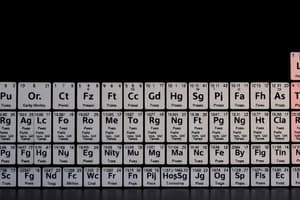Podcast
Questions and Answers
What is the atomic number of Magnesium?
What is the atomic number of Magnesium?
- 16
- 12 (correct)
- 14
- 11
Which element has the symbol 'Cl'?
Which element has the symbol 'Cl'?
- Copper
- Chlorine (correct)
- Calcium
- Carbon
Identify the element with atomic number 8.
Identify the element with atomic number 8.
- Fluorine
- Oxygen (correct)
- Neon
- Nitrogen
What is the symbol for Potassium?
What is the symbol for Potassium?
Which of the following elements has the highest atomic number listed?
Which of the following elements has the highest atomic number listed?
Flashcards are hidden until you start studying
Study Notes
Overview of the Periodic Table
- The periodic table organizes elements based on their atomic numbers, electron configurations, and recurring chemical properties.
- Each element is represented by its unique symbol and atomic number.
Key Elements and Their Properties
-
Hydrogen (H)
- Atomic Number: 1
- Lightest and most abundant element in the universe.
-
Helium (He)
- Atomic Number: 2
- Second most abundant element; a noble gas used in balloons.
-
Lithium (Li)
- Atomic Number: 3
- Used in batteries and mood-stabilizing medications.
-
Beryllium (Be)
- Atomic Number: 4
- Lightweight metal, used in aerospace applications due to its high stiffness.
-
Boron (B)
- Atomic Number: 5
- Key element in glass and ceramics; used as a semiconductor.
-
Carbon (C)
- Atomic Number: 6
- Fundamental building block of life; exists in various allotropes including graphite and diamond.
-
Nitrogen (N)
- Atomic Number: 7
- Makes up about 78% of Earth's atmosphere; essential for amino acids.
-
Oxygen (O)
- Atomic Number: 8
- Vital for respiration in most living organisms; makes up 21% of the atmosphere.
-
Fluorine (F)
- Atomic Number: 9
- Most electronegative and reactive element; used in toothpaste and Teflon.
-
Neon (Ne)
- Atomic Number: 10
- Inert gas, used in neon signs due to its bright illumination.
-
Sodium (Na)
- Atomic Number: 11
- Highly reactive metal, essential for biological organisms; found in salt.
-
Magnesium (Mg)
- Atomic Number: 12
- Lightweight metal; used in aircraft and fireworks.
-
Aluminum (Al)
- Atomic Number: 13
- Most abundant metal in the Earth’s crust; widely used in packaging and construction.
-
Silicon (Si)
- Atomic Number: 14
- Semiconductor used in electronics; second most abundant element in the Earth's crust.
-
Phosphorus (P)
- Atomic Number: 15
- Essential for life; key component of DNA, RNA, and ATP.
-
Sulfur (S)
- Atomic Number: 16
- Used in fertilizers, gunpowder, and pharmaceuticals.
-
Chlorine (Cl)
- Atomic Number: 17
- Used as a disinfectant and in the production of chlorinated compounds.
-
Argon (Ar)
- Atomic Number: 18
- Noble gas; used in light bulbs to prevent filament oxidation.
-
Potassium (K)
- Atomic Number: 19
- Essential mineral for plant growth; plays a key role in cell function.
-
Calcium (Ca)
- Atomic Number: 20
- Crucial for bone health; involved in muscle contractions and nerve signaling.
Studying That Suits You
Use AI to generate personalized quizzes and flashcards to suit your learning preferences.




